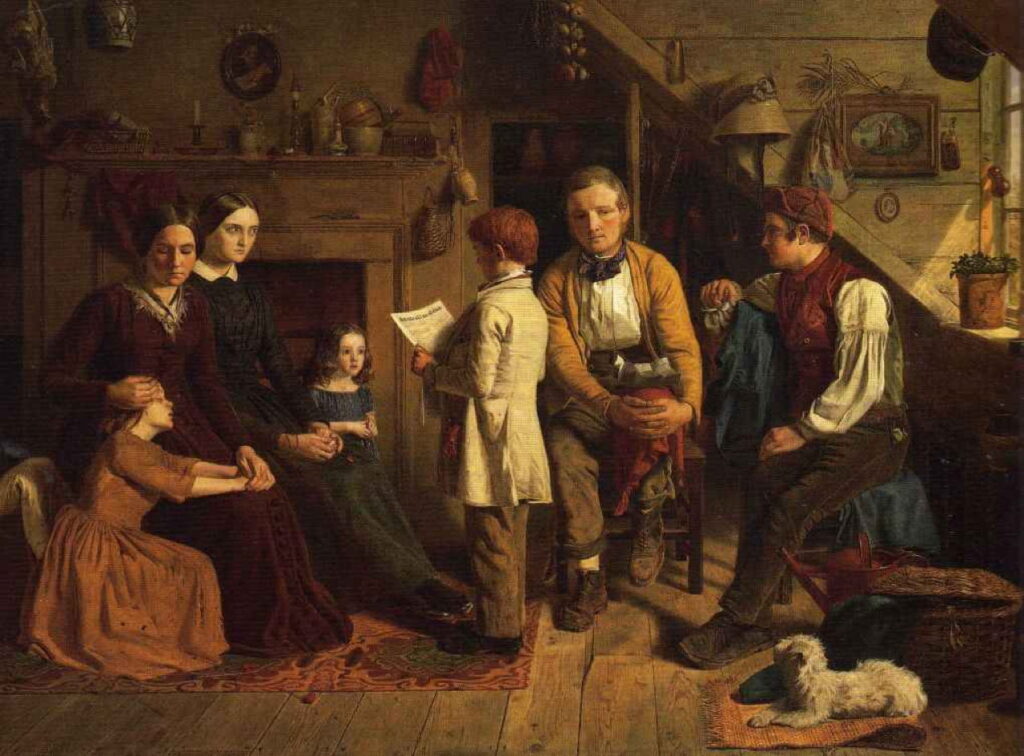The bicentenary of James Collinson, least-known Pre-Raphaelite painter

Many artists are considered to have been part of the Pre-Raphaelite Movement in the latter half of the nineteenth century, and even more adopted Pre-Raphaelite style, but there were only ever seven members of the original Pre-Raphaelite Brotherhood that started it all. Three weren’t even painters, but the other four included William Holman Hunt, John Everett Millais, Dante Gabriel Rossetti, and someone named James Collinson who’s hardly mentioned.
James Collinson was born two centuries ago today, on 9 May 1825, to a Nottinghamshire bookseller and his wife. He made friends with Hunt and Rossetti when they were students together in the Royal Academy Schools in London, and in 1848 they formed the Pre-Raphaelite Brotherhood with the other four.
Most of the paintings by members of the Brotherhood at that time were religious in theme. Collinson painted a few works before the group started to fragment in 1850, as the result of controversy surrounding John Everett Millais’ Christ in the House of His Parents shown at the Royal Academy that year.
John Everett Millais (1829–1896), Christ in the House of His Parents (‘The Carpenter’s Shop’) (1849–50), oil on canvas, 86.4 x 139.7 cm, The Tate Gallery (Purchased with assistance from the Art Fund and various subscribers 1921), London. © The Tate Gallery and Photographic Rights © Tate (2016), CC-BY-NC-ND 3.0 (Unported), http://www.tate.org.uk/art/artworks/millais-christ-in-the-house-of-his-parents-the-carpenters-shop-n03584
Millais’ painting, also known as The Carpenter’s Shop appeared with a quotation from the Old Testament book of Zechariah 13:6: “And one shall say unto him, What are those wounds in thine hands? Then he shall answer, Those with which I was wounded in the house of my friends.” It shows an entirely imagined scene, one not even alluded to in the Gospels, in which the young Jesus Christ is being comforted by his kneeling mother, after he has cut the palm of his left hand on a nail.
The figures and objects are depicted with great and meticulous realism, and were painted from nature. Nevertheless the composition abounds with symbols of Christ’s life and future crucifixion: the cut on his palm is one of the stigmata, and blood dripped from that onto his left foot is another. The young Saint John the Baptist has fetched a bowl of water, indicating his future baptismal role. A triangle above Christ’s head symbolises the Trinity, and a white dove perched on the ladder is the Holy Spirit. A flock of sheep outside represents the Christian flock.
Among its harshest critics was the great novelist Charles Dickens, who claimed that the Holy Family had been made to look like alcoholics and slum-dwellers. Collinson felt that the Brotherhood was bringing the Christian religion into disrepute, and resigned. The group failed to agree on a replacement, and disbanded later that year.
Late that summer, it’s thought that Collinson stayed on the Isle of Wight with Richard Burchett, as both painted views across the same bay from similar locations.
James Collinson (1825–1881), Mother and Child by a Stile, with Culver Cliff, Isle of Wight, in the Distance (c 1850), oil on panel, 52.7 x 42.2 cm, Yale Center for British Art, New Haven, CT. Courtesy of The Yale Center for British Art.
Collinson’s Mother and Child by a Stile, with Culver Cliff, Isle of Wight, in the Distance was painted along a path that still runs between the eastern end of Cliff Copse down to what was then Saint John’s Church (now known as Saint Blasius’) in Shanklin. It’s claimed that either or both the views were made from above or beyond Shanklin Down, which is incorrect: they were both made to the north-east of that down, which towers above those locations, about a mile from our house.
For some time, I believed that there were two significant discrepancies between these paintings and the views these artists would have seen: the distant white tower, the Earl of Yarborough’s Monument, appeared too far to the left in both, and in Burchett’s painting, Saint John’s Church looked incorrect. Although I still have my doubts about the church, and the exact site from which Collinson painted his view, I have since discovered that the distant monument is placed correctly, as it was moved from there to its present location in the 1860s.
James Collinson (1825–1881), Answering the Emigrant’s Letter (1850), oil on canvas, 70.1 x 91.2 cm, Manchester Art Gallery, Manchester, England. Wikimedia Commons.
That year Collinson also painted one of a series of three works on the theme of reading and writing, Answering the Emigrant’s Letter (1850). These may have had their origins in the contemporary campaign for literacy inspired by Dickens’ novel The Old Curiosity Shop (1841). This may be a humble working class family, but both the father and the oldest of their children are writing with quills.
James Collinson (1825–1881), The Emigration Scheme (1852), oil on panel, 56.5 x 76.2 cm, Private collection. Wikimedia Commons.
The Emigration Scheme (1852) is the second in this series, with another older boy demonstrating his reading skills to two families. Emigration was a theme adopted by other Pre-Raphaelites, and many in Britain seized the opportunity to migrate to North America or Australasia.
James Collinson (1825–1881), Home Again (1856), oil on canvas, 82.7 x 115.5 cm, The Tate Gallery, London. Wikimedia Commons.
Collinson painted Home Again after the end of the Crimean War in 1856, to show the problems faced by returning veterans and their dependents. A soldier in the Coldstream Guards here rejoins his family after he was blinded in the war. His large extended family now face the future without the income he had brought in.
In 1858, Collinson married and concentrated his painting on further secular themes, apparently becoming quite popular.
James Collinson (1825–1881), To Let (date not known), oil on canvas, 51.5 x 47 cm, Philadelphia Museum of Art, Philadelphia, PA. Wikimedia Commons.
His undated painted oval To Let is perhaps a little too subtle today. This pretty young woman stands at a window in which she’s advertising an apartment to let. She’s wearing black suggesting that she might be a widow, but there’s no sign of a wedding ring on her left hand. Maybe she intends her tenant to take up more permanent residence.
James Collinson (1825–1881), For Sale (study) (date not known), oil on canvas, 30.6 x 23.8 cm, Private collection. Wikimedia Commons.
This study for a finished painting titled For Sale also has subtle open narrative and gives even fewer clues as to the artist’s intent.
Collinson served as secretary to the Society of British Artists between 1861-70, then went to live in Brittany. He died in 1881, and has since been almost entirely forgotten, the only one of the four painters among the Pre-Raphaelite Brotherhood who has vanished.




